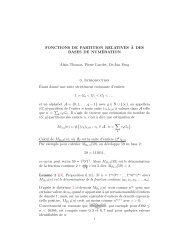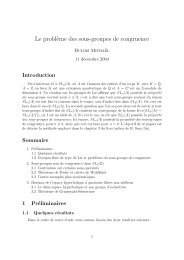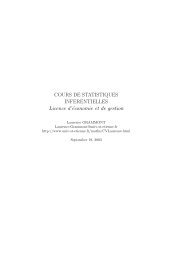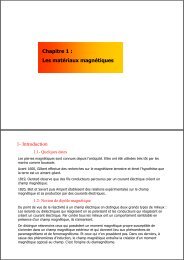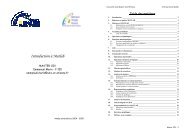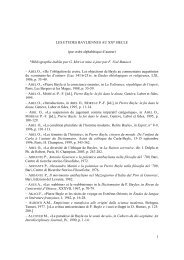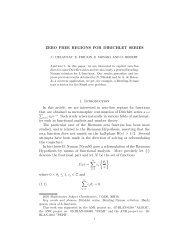COURS DE PROBABILITE 2i`eme année d'économie et de gestion ...
COURS DE PROBABILITE 2i`eme année d'économie et de gestion ...
COURS DE PROBABILITE 2i`eme année d'économie et de gestion ...
You also want an ePaper? Increase the reach of your titles
YUMPU automatically turns print PDFs into web optimized ePapers that Google loves.
<strong>COURS</strong> <strong>DE</strong> <strong>PROBABILITE</strong>2ième année d’économie <strong>et</strong> <strong>de</strong> <strong>gestion</strong>,semestre 2Laurence GRAMMONTLaurence.Grammont@univ-st-<strong>et</strong>ienne.frApril 2, 2004
Contents1 Lois discrètes usuelles 51.1 Introduction . . . . . . . . . . . . . . . . . . . . . . . . . . . . 51.2 Schéma <strong>de</strong> Bernoulli . . . . . . . . . . . . . . . . . . . . . . . 61.3 Schéma Binomial . . . . . . . . . . . . . . . . . . . . . . . . . 71.4 Schéma hypergéométrique . . . . . . . . . . . . . . . . . . . . 101.5 Loi géométrique <strong>et</strong> loi <strong>de</strong> Pascal . . . . . . . . . . . . . . . . . 121.6 Loi <strong>de</strong> Poisson . . . . . . . . . . . . . . . . . . . . . . . . . . . 152 Couple <strong>de</strong> variables aléatoires discrètes 192.1 Généralités . . . . . . . . . . . . . . . . . . . . . . . . . . . . 192.1.1 Loi <strong>de</strong> probabilité conjointeLois <strong>de</strong> probabilité marginales . . . . . . . . . . . . . . 202.2 Fonction <strong>de</strong> répartition d’un coupleFonctions <strong>de</strong> répartition marginales . . . . . . . . . . . . . . . 212.3 Loi <strong>de</strong> probabilité conditionnelleEspérance conditionnelle . . . . . . . . . . . . . . . . . . . . . 222.3.1 Corrélation linéaire . . . . . . . . . . . . . . . . . . . . 232.4 Indépendance stochastique . . . . . . . . . . . . . . . . . . . . 232.5 Equation d’analyse <strong>de</strong> la variance . . . . . . . . . . . . . . . . 252.6 Fonction <strong>de</strong> 2 variables aléatoires discrètes . . . . . . . . . . . 262.6.1 Espérance-Variance . . . . . . . . . . . . . . . . . . . . 262.6.2 Calcul <strong>de</strong> la covariance . . . . . . . . . . . . . . . . . . 263 Couple <strong>de</strong> variables aléatoirescontinues 293.1 Fonction <strong>de</strong> répartition du couple (X, Y )Fonction <strong>de</strong> répartition marginale . . . . . . . . . . . . . . . . 293
4 CONTENTS3.2 Fonction <strong>de</strong>nsité conjointeFonctions <strong>de</strong>nsité marginales . . . . . . . . . . . . . . . . . . . 303.3 Variables conditionnelles . . . . . . . . . . . . . . . . . . . . . 343.3.1 Indépendance en probabilitécovariance-coéfficient <strong>de</strong> corrélation . . . . . . . . . . . 363.3.2 Fonction <strong>de</strong> 2 variables aléatoires . . . . . . . . . . . . 384 Loi Normale ou loi <strong>de</strong> Laplace - Gauss - Généralités 394.1 Définition mathématique . . . . . . . . . . . . . . . . . . . . . 394.2 Calculs <strong>de</strong> probabilité . . . . . . . . . . . . . . . . . . . . . . . 414.2.1 Calculs à partir <strong>de</strong> N (0, 1) : U . . . . . . . . . . . . . . 414.2.2 Loi Normale qq N (µ, σ) . . . . . . . . . . . . . . . . . 435 Condition d’application <strong>de</strong> la loi normale 475.1 Convergence <strong>de</strong>s variables aléatoires . . . . . . . . . . . . . . . 475.1.1 Convergence en loi . . . . . . . . . . . . . . . . . . . . 475.1.2 Convergence en probabilité . . . . . . . . . . . . . . . . 485.2 Loi faible <strong>de</strong>s grands nombres . . . . . . . . . . . . . . . . . . 495.3 Théorème central-limit . . . . . . . . . . . . . . . . . . . . . . 505.4 Approximation d’une loi B(n, p) . . . . . . . . . . . . . . . . . 505.5 Approximation d’une loi <strong>de</strong> Poisson . . . . . . . . . . . . . . . 525.6 Exercices . . . . . . . . . . . . . . . . . . . . . . . . . . . . . . 52
Chapter 1Lois discrètes usuelles1.1 IntroductionOn a un phénomène aléatoire que l’on veut comprendre. Ce phénomènealéatoire est a priori complexe <strong>et</strong> on ne peut calculer directement les probabilités<strong>de</strong> ses éventualités.ex : comprendre la dépense annuelle <strong>de</strong>s ménages français pour les loisirs.Par exemple, calculer la probabilité qu’ils dépensent 5 000 F par an. Ondisposed’une population pour laquelle le modèle est <strong>de</strong>stiné,d’un individu <strong>et</strong>d’un caractère étudié (représenté par une variable aléatoire X).Que fait-on ?1 - Pour avoir une première idée du phénomène représenté par une variablealéatoire X, on peut faire plusieurs observations <strong>de</strong> X.ex : X = dépense annuelle pour les loisirs d’un ménage (variable aléatoireattachée à un individu). On <strong>de</strong>man<strong>de</strong> à un certain nombre <strong>de</strong> ménages sesdépenses annuelles en loisirs. On a donc la valeur <strong>de</strong> X i . X i étant la dépenseannuelle pour le ménage i.C<strong>et</strong>te suite d’observation débouche sur la définition d’une variable statistique5
6 CHAPTER 1. LOIS DISCRÈTES USUELLESx souvent décrite <strong>de</strong> la manière suivante :valeurs <strong>de</strong> xx ifréquencesn iOn étudie c<strong>et</strong>te variable statistique à l’ai<strong>de</strong> <strong>de</strong>s techniques <strong>de</strong>s statistiques<strong>de</strong>scriptives (1 ere année)2 - Il y a quelques lois <strong>de</strong> probabilité ou lois théoriques qui décrivent assezbien un grand nombre <strong>de</strong> phénomènes aléatoires. On veut représenter lephénomène aléatoire par une loi <strong>de</strong> probabilité théorique. C<strong>et</strong>te modélisationest évi<strong>de</strong>mment plus riche que la représentation par une variable statistique: ici on peut calculer la probabilité <strong>de</strong> tout événementassocié au phénomènealéatoire. Dans ce chapitre, nous allons fournir un catalogue <strong>de</strong> lois <strong>de</strong> probabilitédiscrètes (<strong>de</strong>scription, étu<strong>de</strong>) souvent utiles en pratique.Le statisticien plus chevroné construira ses propres modèles théoriques.3 - Après le choix d’un modèle théorique se pose la question suivante : peut-onquantifier l’approximation du phénomène aléatoire par le modèle théorique.1.2 Schéma <strong>de</strong> BernoulliToute épreuve n’ayant que 2 résultats possibles peut-être considérée commeune situation d’alternative.En d’autres termes, les 2 résultats possibles sont complémentaires l’un <strong>de</strong>l’autre.Il s’agit d’une situation fréquente dans la pratique dès que l’on cherche àm<strong>et</strong>tre en évi<strong>de</strong>nce un caractère particulier au sein d’une population :tout individu <strong>de</strong> c<strong>et</strong>te population peut être décrit selon une alternative : soitil présente ce caractère, soit il ne le présente pas.Exemple : Etu<strong>de</strong> <strong>de</strong> l’impact d’une campagne publicitaire pour un nouveauproduit.Q1 : Est-ce que l’individu possédait ce produit auparavant ?Q2 : L’individu a-t-il été touché par la campagne ?Q3 : La campagne a-t-elle induit l’achat ?
1.3.SCHÉMA BINOMIAL 7Souvent les résultats possibles sont <strong>de</strong>s obj<strong>et</strong>s qualitatifs. Pour les quantifier,il faut leur trouver un codage.On définit ainsi une v.a. X dites <strong>de</strong> Bernoulli (savant suisse 1654-1705) par0 11 − p pDéfinitionOn réalise une expérience aléatoire qui a 2 résultats possibles : le succès S, <strong>de</strong> probabilité. p,<strong>et</strong> l’Echec{E <strong>de</strong> probabilité 1 − p. La v.a1 si succès est une v.a. <strong>de</strong> BernoulliX :0 si échecMo<strong>de</strong>p > q Mo<strong>de</strong> = 1p < q Mo<strong>de</strong> = 0Médianep > q ⇒ q < 1/2 Me = 1p < q ⇒ q > 1/2 Me = 0PropriétéE(X) = pV (X) = p(1 − p)Remarque :La v.a. <strong>de</strong> Bernoulli est une v.a. indicatrice : elle indique la réalisationéventuelle <strong>de</strong> l’événement<strong>de</strong> probabilité p. Le shéma <strong>de</strong> Bernoulli est le plussimple <strong>de</strong>s modèles probabilistes.1.3 Schéma BinomialC’est une succession d’épreuves <strong>de</strong> Bernoulli (n) indépendantes.Définition :
8 CHAPTER 1. LOIS DISCRÈTES USUELLESOn réalise n fois successivement <strong>et</strong> d’une manière indépendante une expérience aléatoirequi a 2 résultats possibles, S (succès) <strong>de</strong> probabilité p <strong>et</strong> E (échec) <strong>de</strong> probabilité 1 − pX = nombre <strong>de</strong> succès obtenus est une v.a. binomiale <strong>de</strong> paramètre n <strong>et</strong> p.Notation B(n, p).Remarque :On peut également la définir comme une somme <strong>de</strong> v.a. <strong>de</strong> Bernoulli.A chaque épreuve i, on associe la v.a. <strong>de</strong> Bernoulli X iX =n∑X i .i=1Loi <strong>de</strong> probabilité X ∼ B(n, p)X(Ω) = {0, . . . , n}P (X = k) = Cn k p k (1 − p) n−k ∀k ∈ X(Ω)n : nb d’épreuves,k : nb <strong>de</strong> S (succès),p : probabilité du succès.PropriétésE(X) = np∥ V (X) = np(1 − p)PropriétéSiX 1 ∼ B(n 1 , p) <strong>et</strong> X 2 ∼ B(n 2 , p)avecX 1 , X 2 indépendantes, alorsX 1 + X 2 ∼ B(n 1 + n 2 , p)Preuve : somme <strong>de</strong> v.a Benouilli.Il y a <strong>de</strong>s tables pour éviter <strong>de</strong> calculer les probabilités d’ événements liés àla loi binomiale. On peut également, dans certains cas, approximer B(n, p)par une autre loi.Exercice :Une machine à embouteiller peut tomber en panne. La probabilité d’unepanne à chaque emploi est <strong>de</strong> 0,01. La machine doit être utilisée 100 fois.
1.3.SCHÉMA BINOMIAL 9Soit X= nb <strong>de</strong> pannes obtenues après 100 utilisations.1) Quelle est la loi <strong>de</strong> X ?Calculer P (X = 0) ; P (X = 1) ; P (X ≥ 4).2) On estime le coût d’une réparation à 500 F.Y : dépense pour les réparations après 100 utilisations.Exprimer Y en fonction <strong>de</strong> X <strong>et</strong> calculer E(Y ) V (Y ).Solution :1) X ∼ B(100, 0, 01) ; P (X = 0) = C 0 100(0, 01) 0 0, 99 100 = 0, 366P (X = 1) = C 1 1000, 01 0, 99 99 = 100 × 0, 01 × 0, 99 99 = 0, 377P (X ≥ 4) = 1 − (. . .) = 0, 0612) Y = 500XE(Y ) = 500 E(X) = 500 × 100 × 0, 01 = 500V (Y ) = 500 2 V (X) = 500 2 0, 99 = 247500Exercice :Dans une pépinière 95% <strong>de</strong>s scions (jeunes arbres greffés) sont supposés sansvirus. Par commodité les scions sont rangés par paqu<strong>et</strong>s <strong>de</strong> 2. Un paqu<strong>et</strong> estdit sain si les 2 scions le sont.1) Proba d’avoir un paqu<strong>et</strong> sain ?2) X = nb <strong>de</strong> paqu<strong>et</strong>s sains sur un lot <strong>de</strong> 10Quelle est la loi <strong>de</strong> X ?3) Un lot <strong>de</strong> 10 est accepté par l’ach<strong>et</strong>eur si 9 au moins <strong>de</strong>s paqu<strong>et</strong>s sontsains. Proba qu’un lot soit accepté ?Solution :1) p = 0, 95 × 0, 95 = 0, 90252) X ∼ B(10, p)3) P (X ≥ 9) = P (X = 9) + P (X = 10)= 0, 7361RemarqueLe schéma binomial correspond au processus <strong>de</strong> tirage d’un échantillon aléatoireavec remise :N 1 : nb d’individus ayant la propriété SN 2 : nb d’individus n’ayant pas la propriété SN = N 1 + N 2 : nb total d’individusOn fait n tirages avec remiseSoit X = nb d’individus ayant la propriété S
10 CHAPTER 1. LOIS DISCRÈTES USUELLESX ∼ B(n, p) avec p = N 1NPropriétéCalcul en chaine <strong>de</strong>s probalités <strong>de</strong> la loi binomiale.Si X ∼ B(n, p) alors(n − k + 1)pP (X = k) = P (X = k − 1)k(1 − p)P (X = k)Preuve :P (X = k − 1) = n − k + 1 pk 1 − p1.4 Schéma hypergéométriqueExemple : En pratique lorsque l’on tire un échantillon <strong>de</strong> taille n parmi unepopulation <strong>de</strong> taille N, le bon sens veut que l’on ne prenne pas 2 fois lemême individu. Cela signifie que le tirage se fait sans remise. Les v.a <strong>de</strong>Bernoulli associées aux différents éléments <strong>de</strong> l’échantillon <strong>et</strong> indicatrices <strong>de</strong>la présence ou absence d’un caractère donné, sont alors dépendantes. Leschéma binomiale n’est plus adapté.Le schéma hypergéométrique est une succession d’épreuves <strong>de</strong> Bernoulli nonindépendantes.DéfinitionSi dans une population <strong>de</strong> taille N,on a 2 types <strong>de</strong> populationsN 1 individus type 1 en proportion p = N 1N <strong>et</strong>N 2 individus type 2 : N 2On fait n tirages sans remise dans la population <strong>et</strong> la v.aX = nb individus <strong>de</strong> type 1 dans l’échantillonX obéit au schéma hypergéométrique H(N, n, p)X = ∑ iX i , avec X i <strong>de</strong>s v.a <strong>de</strong> Bernoulli non indépendantes.Loi <strong>de</strong> probabilité
1.4.SCHÉMA HYPERGÉOMÉTRIQUE 11Si X ∼ H(N, n, p), alors{ n < N2Les valeurs <strong>de</strong> X sont les entiers compris entre 0 <strong>et</strong> n sin < N 1P (X = k) = Ck N 1× C n−kN 2(dénombrement classique)CNnPropriétésE(X) = npV (X) = np(1 − p) N − nN − 1Théorème :<strong>et</strong>Quand N → +∞ avec n, p fixes, alorsla loi hypergéométrique H(N, n, p) tend vers la loi binomiale B(n, p).Que signifie une loi qui tend vers une autre loi ? (cf chap. conditiond’application)Dans la pratique, on utilise l’approximation dès que n N < 0, 1preuve :(Np)!(Nq)!n!(N − n)!P (X = k) =k!(Np − k)!(n − k)!(Nq − n + k)! N!∼ (Np)k (Nq) n−k n!∼ p k q n−k n!k!(n − k)!N n k!(n − k)! = Ck np k q n−kExemple 1A un guich<strong>et</strong> SNCF se présentent 2 femmes <strong>et</strong> 3 hommes. On choisit auhasard 2 personnes ≠ pour une enquête.Soit X = nb <strong>de</strong> femmes.a) Probabilité <strong>de</strong> choisir une femme au moins.b) Calculer E(X) <strong>et</strong> σ(X).(a) X ∼ H 5, 2, 2 5□P (X ≥ 1) = P (X = 1) + P (X = 2) = C1 2C 1 3C 2 5b) E(X) = np = 2 × 3 5 = 4 5 = 0, 8+ C2 2C 0 3C 2 5= 7 10 = 0, 7
12 CHAPTER 1. LOIS DISCRÈTES USUELLESV (X) = npq N − nN − 1 = 2 × 2 5 × 3 5 × 3 4 = 9 25σ(X) = 0, 6= 0, 36Exemple 2On choisit au hasard 10 étudiants <strong>de</strong> <strong>DE</strong>UG ≠ pour un entr<strong>et</strong>ien : 304étudiants sont inscrits en 1ère année, 233 en 2ème .X = nb d’étudiants <strong>de</strong> 1ère année parmi les 10.Calculer la probabilité d’avoir 5 étudiants <strong>de</strong> 1ère année <strong>et</strong> déterminer E(X)<strong>et</strong> σ(X).X ∼ H(537, 10, 304537 )P (X = 5) = C5 304C 5 233C 10537≃ 0, 227Mais on peut utiliser l’approximationComme n N = 10(537 < 0, 1, on peut approximer HP (X = 5) = C 5 10( 304537E(X) = np = 10 × 304537V (X) = npq N − n) 5 ( 233537= 5, 661) 5≃ 0, 225.304= 10 ×537 × 233537 × 527536N − 1σ(X) = 1, 554avec l’approximation σ(X) = √ npq = 1, 567.537, 10, 304 )537≃ 2, 415(par B 10, 304 )5371.5 Loi géométrique <strong>et</strong> loi <strong>de</strong> PascalOn se place dans une optique différente.A la base, il y a toujours l’épreuve <strong>de</strong> Bernoulli qui a 2 résultats possibles :un événement<strong>de</strong> probabilité p <strong>et</strong> l’autre. Mais c<strong>et</strong>te fois, on ne connait pasle nombre d’épreuves.DéfinitionX suit la loi géométrique <strong>de</strong> paramètre p, G(p), si elle est égale au nombre d’épreuves <strong>de</strong>Bernoulli indépendantes qu’il faut réaliser pour obtenir pour la 1ère fois l’événement<strong>de</strong>probabilité p.
1.5. LOI GÉOMÉTRIQUE ET LOI <strong>DE</strong> PASCAL 13Loi <strong>de</strong> probabilitéX(Ω) = N ∗ , (l’ensemble <strong>de</strong>s valeurs est ∞ dénombrable)P (X = k) = q k−1 pk ∈ N ∗fonction <strong>de</strong> répartitionn∑P (X ≤ n) = q k−1 p = pk=1F X (n) = 1 − q ncaractéristiques∑n−1K=0q k = p 1 − qn1 − q = 1 − qnE(X) = 1 pV (X) = 1 − pp 2La loi <strong>de</strong> Pascal est la généralisation <strong>de</strong> la loi géométrique lorsque l’ons’intéresse à l’obtention pour la k ième fois <strong>de</strong> l’événement<strong>de</strong> probabilité pDéfinitionX suit la loi <strong>de</strong> Pascal G(k, p), si elle est égale au nombre d’épreuves <strong>de</strong> Bernoulliindépendantes qu’il faut réaliser pour obtenir pour la kèm fois l’événement<strong>de</strong>probabilité p.Loi <strong>de</strong> probabilitéX(Ω) = {k, . . . , ∞}P (X = j) = C k−1j−1 pk−1 q j−k p j ≥ kCaractéristiquesE(X) = k pk(1 − p)V (X) =p 2Remarque : la ressemblance avec la loi binomiale n’est qu’apparente. Lagran<strong>de</strong> différence est que le nombre <strong>de</strong> répétitions <strong>de</strong> l’épreuve élémentaire<strong>de</strong> Bernoulli n’est pas connu, <strong>et</strong> c’est lui qui représente l’aléatoire du problème
14 CHAPTER 1. LOIS DISCRÈTES USUELLES!• ApplicationCes 2 lois interviennent particulièrement en contrôle <strong>de</strong> qualité mais aussidans la surveillance <strong>de</strong>s événements dont une certaine fréquence <strong>de</strong> survenueest interprétée en terme <strong>de</strong> signal d’alarme.• Remarque <strong>de</strong> modélisationLa probabilité <strong>de</strong> l’événement qui nous intéresse est toujours p, elle estconstante au cours du temps. C<strong>et</strong>te propriété <strong>de</strong> stationnarité n’est passystématique dans les situations réelles que l’on doit modéliser.ExempleSupposons que 5 % <strong>de</strong>s pièces en sortie d’une chaine <strong>de</strong> production soientdéfectueuses. On souhaite connaitre la probabilité qu’un échantillon <strong>de</strong> 20pièces issu <strong>de</strong> c<strong>et</strong>te chaine ne contienne aucune pièce défectueuse.On peut traiter c<strong>et</strong> exemple en utilisant soit la loi Binomiale,soit la loi géométrique.- chaque pièce est in<strong>de</strong>ntifiée par un caractère à 2 modalités :défectueusenon défectueuseLa modélisation <strong>de</strong> base est donc le schéma <strong>de</strong> Bernoulli avec p = 0, 05. Onpeut faire l’hypothèse <strong>de</strong> l’indépendance <strong>de</strong>s épreuves <strong>de</strong> Bernoulli (grand<strong>et</strong>aille <strong>de</strong> la population). Soit la v.a X = nb <strong>de</strong> défectueux après la réalisation<strong>de</strong> 20 épreuves <strong>de</strong> Bernoulli. On aX ∼ B(20, 0, 05)P (X = 0) = 0, 95 20 = 0, 3585.- On gar<strong>de</strong> la modélisation <strong>de</strong>s pièces par les aléas <strong>de</strong> Bernoulli. On faitl’hypothèse d’indépendance (gd nb <strong>de</strong> pièces). Mais le nombre <strong>de</strong> piècesn’est plus donné : c’est un aléa.Soit la v.a Y = nombre <strong>de</strong> pièces observées jusqu’à l’obtention d’une piècedéfectueuse.Y ∼ G(0, 05)
1.6. LOI <strong>DE</strong> POISSON 15P (Y ≥ 21) =∞∑k=210, 95 k−1 201 − 0, 95∞0, 05 = 0, 95 × 0, 051 − 0, 95200, 05= 0, 95 = 0, 35850, 051.6 Loi <strong>de</strong> PoissonSiméon-Denis Poisson(1781-1840)est un probabiliste, mathématicien <strong>et</strong> physicienfrançais à qui l’on doit d’importants développements sur la loi <strong>de</strong>s grandsnombres, les suites d’épreuves <strong>de</strong> Bernoulli mais aussi sur les applications <strong>de</strong>sprobabilités dans le domaine du droit.définitionX est une v.a. <strong>de</strong> Poisson <strong>de</strong> paramètre m si <strong>et</strong> seulement siX(Ω) = N <strong>et</strong>P (X = k) = mkk! e−mNotation : P(m)On est dans la situation X(Ω) infini dénombrable.On peut maintenant poser la loi <strong>de</strong> Poisson comme modèle d’une épreuvealéatoire :Théorème d’approximationSoit X ∼ B(n, p)quand n → +∞ <strong>et</strong>p → 0 tq np → m,alors X L → P(m)ModélisationLorsqu’un événement a une faible probabilité p d’apparition lors d’une épreuve<strong>de</strong> Bernoulli <strong>et</strong> si l’on répète un grand nombre <strong>de</strong> fois c<strong>et</strong>te épreuve (n) lenombre total <strong>de</strong> réalisations <strong>de</strong> l’événement considéré suit à peu près une loi<strong>de</strong> Poisson <strong>de</strong> paramètre m = np.Dans la pratique :n > 50p < 0, 1
16 CHAPTER 1. LOIS DISCRÈTES USUELLESRmq : plus p est p<strong>et</strong>it, meilleure est l’approximation.la loi <strong>de</strong> Poisson a été appelée loi <strong>de</strong>s phénomènes rares.Pour c<strong>et</strong>te raisonLes processus <strong>de</strong> Poisson sont fréquents dans les problèmes <strong>de</strong> <strong>gestion</strong> :- nb <strong>de</strong> pièces défectueuses dans un échantillon <strong>de</strong> gran<strong>de</strong> taille prélevé dansune production où la proportion <strong>de</strong>s défectueuses est faible.- nb <strong>de</strong> quadruplés, quintuplés par an dans un pays donné.- nb d’appels intercontinentaux sur une ligne pendant une durée donnée.- nb d’erreurs commises au cours d’une longue suite d’opérations (inventaire).- pannes <strong>de</strong> machine.- émission <strong>de</strong> particules radio-actives.caractéristiques Si X ∼ P(m),alors E(X) = mV (X) = mIl faut savoir que ∑ k≥0E(X)V (X)= ∑ k≥0= ∑ k≥0= m 2 ∑ k≥2= mm kk!= e mk mkk! e−m = e −m m ∑ k≥1m k−1(k − 1)! = mk 2 mkk! e−m − m 2 = ∑ k(k − 1) mkk! e−m + ∑K≥1k≥1m k−2(k − 2)! e−m + m ∑ k≥1m k−1(k − 1)! e−m − m 2k mkk! e−m − m 2Propriété : somme <strong>de</strong> v.a <strong>de</strong> PoissonSi X 1 <strong>et</strong> X 2 sont 2 variables <strong>de</strong> Poisson P(m 1 ), P(m 2 ) indépendantes alorsX 1 + X 2 ∼ P(m 1 + m 2 )(ceci est vrai pour une somme finie quelconque <strong>de</strong> v.a <strong>de</strong> Poisson indépendantes)Preuve :
1.6. LOI <strong>DE</strong> POISSON 17P (Y = k) = P (X 1 + X 2 = k)PropriétéSi X ∼ P(m)P (X = k)P (X = k − 1) = m k[ k]⋃= P {X 1 = i} ∩ {X 2 = k − i}=i=0k∑P (X 1 = i).P (X 2 = k − i)i=0K∑ m i 1 m k−i=i! e−m 1 2(k − i)! e−m 2i=0K∑= Ckm i i 1m k−i e −(m 1+m 2 )2k!i=0= (m 1 + m 2 ) ke −(m 1+m 2 )□.k!Conséquence statistiqueOn peut envisager une loi <strong>de</strong> Poisson comme modèle représentatif <strong>de</strong> données statistiquesdiscrètes pour lesquelles la variable ne prend que <strong>de</strong>s valeurs entières, positivesou nulles <strong>et</strong> pour lesquelles- la moyenne ≃ la variance <strong>et</strong>f k- est proportionnel à 1 f k−1 kExemple 1f k étant les fréquences.Lors d’un sondage portant sur un grand nombre <strong>de</strong> personnes, on sait que 2%<strong>de</strong>s personnes interrogées acceptent <strong>de</strong> ne pas rester anonymes. Sachant quel’un <strong>de</strong>s son<strong>de</strong>urs a interrogé 250 personnes (en les choisissant <strong>de</strong> manièreindépendante), calculer la probabilitéa) que ces 250 personnes souhaitent rester anonymesb) 3 personnes acceptent <strong>de</strong> ne pas rester anonymesc) plus <strong>de</strong> 10 personnes acceptent <strong>de</strong> ne pas rester anonymesX = nb <strong>de</strong> personnes ne souhaitant pas rester anonymes.X ∼ B(250, 0, 02) P(5).−5 50P (X = 0) = e = e −5 = 0, 0067,0!
18 CHAPTER 1. LOIS DISCRÈTES USUELLES−5 53P (X = 3) = e = 0, 14,3!P (X ≥ 10) = 1 − P (X < 10) = 1 − P (X ≤ 9).Exemple 2Dans un hôpital parisien, il arrive en moyenne 1,25 personnes à la minuteaux urgences entre 9 h <strong>et</strong> 12 h.X : nb <strong>de</strong> personnes observées à la minute à l’entrée <strong>de</strong> ce service.On adm<strong>et</strong> X ∼ P(m) avec m = 1, 25Déterminer les probabilités suivantesa) En 1mn il arrive 2 personnes b) 4 personnes au plus c) 3 personnes aumoins.a) P (X = 2) = 0, 2238b) P (X ≤ 4) = 0, 9909c) P (X ≥ 3) = 1 − P (X ≤ 2)= 1 − 0, 8685= 0, 1315.
Chapter 2Couple <strong>de</strong> variables aléatoiresdiscrètes2.1 GénéralitésOn se consacre à l’étu<strong>de</strong> simultanée <strong>de</strong> 2 variables aléatoires X, Y discrètes.(X, Y ) est appelé couple aléatoire ou variable aléatoire à 2 dimensions ouvecteur aléatoire <strong>de</strong> dimension 2.Exemples :Expérience aléatoire : choisir un individu dans une population P,X : taille d’un individu, Y : poids d’un individu.Expérience aléatoire : 2 j<strong>et</strong>s successifs d’un dé,X = nb <strong>de</strong> points du 1 er j<strong>et</strong>,Y = somme <strong>de</strong>s points.Soient X, Y <strong>de</strong>ux v.a. discrètes. Dans la suite, on utilisera les notationssuivantes:X(Ω) = {x 1 , . . . , x n }Y (Ω) = {y 1 , . . . , y p }19
20CHAPTER 2.COUPLE <strong>DE</strong> VARIABLES ALÉATOIRES DISCRÈTES2.1.1 Loi <strong>de</strong> probabilité conjointeLois <strong>de</strong> probabilité marginalesDéfinitionLa loi <strong>de</strong> probabilité conjointe <strong>de</strong> X <strong>et</strong> Y ou loi du couple (X, Y ) est définie par1) les valeurs <strong>de</strong> (X, Y ) {(x i , y i ) i ∈ {1, . . . , n} j ∈ {1, . . . , p}}2) les probabilités correspondantesp ij = P ((X, Y ) = (x i , y i ))= P (X = x i , Y = y j )= P ((X = x i ) ∩ (Y = y j ))Présentation : dans un tableau :valeurs <strong>de</strong> Xvaleurs <strong>de</strong> Y y 1 y 2 . . . y px 1 p 11 p 12 + + p 1px 2 p 21 p 22 p 2p.x n p n1 p n2 p npQuestion 1 :Si on a la loi <strong>de</strong> probabilité du couple (X, Y ), peut-on en déduire la loi <strong>de</strong>probabilité <strong>de</strong> X <strong>et</strong> la loi <strong>de</strong> probabilité <strong>de</strong> Y ?réponse : oui mais l’inverse n’est pas vrai.DéfinitionSi on donne la loi du couple (X, Y ), la loi <strong>de</strong> probabilité <strong>de</strong> X <strong>et</strong> celle <strong>de</strong> Y sont appeléeslois <strong>de</strong> probabilité marginales.Propriétépour X : P (X = x i ) =pour Y : P (Y = y j ) =preuve : TVAp∑j=1n∑i=1p ijp ij(somme d’une ligne du tableau)(somme d’une colonne)
2.2. FONCTION <strong>DE</strong> RÉPARTITION D’UN COUPLEFONCTIONS <strong>DE</strong> RÉPARTITION MARGINNotationsp i• = P (X = x i ) =p •j = P (Y = y j ) =Propriétép∑j=1n∑i=1p ijp ijn∑ p∑p ij = 1i=1 j=12.2 Fonction <strong>de</strong> répartition d’un coupleFonctions <strong>de</strong> répartition marginalesDéfinitionLa fonction <strong>de</strong> répartition du couple (X, Y ) est définie parF X,Y (x, y) = P [(X ≤ x) ∩ (Y ≤ y)]PropriétéF (X,Y ) (x, y) =∑ i tqx i ≤x∑j tqy j ≤yp ijQuestion 2 : Si on a F (X,Y ) (x, y) peut-on en déduire F X (x) <strong>et</strong> F Y (y) lesfonctions <strong>de</strong> répartition marginales.réponse : ouiF X (x) = lim F (X,Y )(x, y)y→+∞F Y (y) = lim F (X,Y )(x, y)x→+∞
22CHAPTER 2.COUPLE <strong>DE</strong> VARIABLES ALÉATOIRES DISCRÈTES2.3 Loi <strong>de</strong> probabilité conditionnelleEspérance conditionnelleDéfinitionOn appelle variable aléatoire conditionnelle X sachant Y = y j , notée X|Y = y jla v.a. discrète <strong>de</strong> valeurs {x i , i = 1, . . . , n}<strong>et</strong> dont les probabilités sontP (X = x i |Y = y j ) = p ijp •jPropriétésn∑P (X = x i |Y = y j ) = 1i=1p∑P (Y = y j |X = x i ) = 1j=1∀y j∀x iDéfinitionOn appelle espérance conditionnelle <strong>de</strong> X sachant Y = y j la quantitéE(X|Y = y j ) =n∑x i P (X = x i |Y = y j ).i=1Théorème <strong>de</strong> l’espérance conditionnellep∑E(X) = E(X|Y = y j )P (Y = y j )preuve :j=1p∑E(X|Y = y j ) P (Y = y j ) =j=1p∑j=1n∑i=1x ip ijp •j× p •j ==n∑i=1x i∑ Pp ijj=1n∑p i• x i = E(X)i=1
2.4.INDÉPENDANCE STOCHASTIQUE 232.3.1 Corrélation linéaireDéfinitionOn appelle covariance du couple (X, Y ) la quantitécov(X, Y ) = E(XY ) − E(X)E(Y )On appelle corrélation linéaire entre X <strong>et</strong> Yρ(X, Y ) = cov(X, Y )√V (X)V (Y )Propriétés−1 ≤ ρ(X, Y ) ≤ 1 (1)V (X + Y ) = V (X) + V (Y ) + 2cov(X, Y ) (2)cov(a X, Y ) = a cov(X, Y ) (3)2.4 Indépendance stochastiqueDéfinition2 v.a.d. X <strong>et</strong> Y sont indépendantes en probabilité (ou stochastiquement) si l’une <strong>de</strong> cespropriétés équivalentes est vérifiée (si elle a un sens) :(i)∀i ∈ {1, . . . , n}∀j ∈ {1, . . . , p}P (X = x i |Y = y i ) = P (X = x i ).(ii) ∀i, ∀j P (Y = y j |X = x i ) = P (Y = y j ).(iii) ∀i, ∀j P (X = x i ∩ Y = y j ) = P (X = x i ) × P (Y = y j ).Propriétés(1) Si X <strong>et</strong> Y sont indépendantes en probabilité alors ρ(X, Y ) = 0(2) Si ρ(X, Y ) ≠ 0 alors X <strong>et</strong> Y ne sont pas indépendantes en probabilité(3) Si ρ(X, Y ) = 0 alors X <strong>et</strong> Y ne sont pas forcément indépendantes en probabilité.ExempleUne urne contient b boules blanches (B) <strong>et</strong> r boules rouges (R).On tire une boule au hasardB → 0Soit X :R → 1Si la boule tirée est B on la rem<strong>et</strong> accompagnée <strong>de</strong> n autres boules blanches.
24CHAPTER 2.COUPLE <strong>DE</strong> VARIABLES ALÉATOIRES DISCRÈTESSi elle est R, on la rem<strong>et</strong> avec n autres rouges.On tire alors une boule.B → 0Soit Y :R → 1a) Donner la loi <strong>de</strong> probabilité <strong>de</strong> (X, Y ).b) Lois marginales.c) indépendance stochastique ?solutionX prend les valeurs 0 <strong>et</strong> 1 <strong>et</strong>Y prend les valeurs 0 <strong>et</strong> 1. On aP (X = 0 ; Y = 0) = P (X = 0 ∩ Y = 0)= P (Y = 0|X = 0) × P (X = 0)↑la v.a. Y est conditionnée à la valeur <strong>de</strong> XP (Y = 0|X = 0)⇒ P (X = 0, Y = 0) = bb + rP (X = 0) = P (B) =bb + r= proba <strong>de</strong> tirer une blanche sachant qu’on a tiré une B au 1er tirage= proba <strong>de</strong> tirer une blanche dans une urne qui comprend r rouges <strong>et</strong>b + n blanches= b + nb + r + n .b + nb + r + nP (X = 1 ∩ Y = 1) = P (Y = 1|X = 1) × P (X = 1)= r + n r.b + r + n b + rX \ Y 0 1 Loi <strong>de</strong> Xb(b + n)r bb0(b + r)(b + r + n) (b + r)(b + r + n) b + rb r(r + n)r r1(b + r)(b + r + n) (b + r)(b + r + n) b + rbrLoi <strong>de</strong> Y1b + rb + rSi X <strong>et</strong> Y étaient indépendantes on aurait par exemple
2.5. EQUATION D’ANALYSE <strong>DE</strong> LA VARIANCE 25( )b bb + n × =b + rb(b + n)b + r(b + n + r)⇔bb + r = b + nb + n + r⇔ b(b + n + r) = (b + n)(b + r)⇔ b 2 + bn + br = b 2 + nb + nr + br⇔ nr = 0 (impossible)2.5 Equation d’analyse <strong>de</strong> la varianceDéfinitionOn appelle variance conditionnelle <strong>de</strong> X|Y = y j la variance <strong>de</strong> la variable aléatoireconditionnelle X sachant Y = y j soit :n∑V (X|Y = y j ) = x 2 i P (X = x i |Y = y j ) − E 2 (X|Y = y j )i=1PropriétéEquation d’analyse <strong>de</strong> la variance.V (X) = V inter (X) + V intra (X)oùp∑V inter (X) = E(X|Y = y j ) 2 P (Y = y j ) − E(X) 2V intra (X) =j=1p∑V (X|Y = y j )P (Y = y j )j=1Preuve :
26CHAPTER 2.COUPLE <strong>DE</strong> VARIABLES ALÉATOIRES DISCRÈTESV (X) ===n∑p∑x 2 i P (X = x i ) − E 2 (X) or P (X = x i ) = P (X = x i ∩ Y = y j )(j=1n∑ p∑)x 2 i P (X = x i |Y = y j )P (Y = y j ) − E 2 (X)j=1)p∑x 2 i P (X = x i |Y = y j ) P (Y = y j ) − E 2 (X)i=1i=1( n∑j=1 i=1p∑ (= V (X|Y = yj ) + E 2 (X|Y = y j ) ) P (Y = y j ) − E 2 (X)=j=1p∑V (X|Y = y j )P (Y = y j ) +j=1} {{ }V intra (X)p∑E 2 (X|Y = y j )P (Y = y j ) − E 2 (X)j=1} {{ }V inter (X)2.6 Fonction <strong>de</strong> 2 variables aléatoires discrètes2.6.1 Espérance-VarianceSoit Z = ϕ(X, Y ) avec ϕ : R 2 → R, une v.a<strong>de</strong> valeurs z ij = ϕ(x i , y j )P (Z = z ij ) = P (ϕ(X, Y ) = ϕ(x i , y j )).On peut calculer E(Z) <strong>et</strong> V (Z) sans avoir à calculer la loi <strong>de</strong> Z :PropriétéE(Z) = ∑ i,jV (Z) = ∑ i,jp ij ϕ(x i , y i )p ij ϕ 2 (x i , y i ) − E(Z) 22.6.2 Calcul <strong>de</strong> la covariancecov(X, Y ) = E(XY ) − E(X)E(Y ),E(XY ) = ∑ x i y i p ij . Propriétéi,j
2.6. FONCTION <strong>DE</strong> 2 VARIABLES ALÉATOIRES DISCRÈTES 27E(XY ) ==n∑x i E(Y |X = x i )P (X = x i )i=1n∑y j E(X|Y = y j )P (Y = y j )j=1Preuve :n∑x i E(Y |X = x i )P (X = x i )i=1j= ∑ ∑x i y j P (Y = y j |X = x i )P (X = x i )i= ∑ x i y j P (Y = y j ∩ X = x i )i,j= ∑ i,jx i y j p ij □.
28CHAPTER 2.COUPLE <strong>DE</strong> VARIABLES ALÉATOIRES DISCRÈTES
Chapter 3Couple <strong>de</strong> variables aléatoirescontinuesSoient (X, Y ) <strong>de</strong>ux variables aléatoires continues.exemple : Pour décrire la position d’un point aléatoire M dans un repèrecartésien, on utilise le couple <strong>de</strong> variables aléatoires (X, Y ) où X désignel’abscisse <strong>et</strong> Y l’ordonnée.Remarque : si on est dans l’espace, on repère un point à l’ai<strong>de</strong> d’un tripl<strong>et</strong> <strong>de</strong>variables aléatoires (X, Y, Z). On peut ainsi généraliser à un vecteur aléatoireà n composantes : par exemple un circuit électrique composé <strong>de</strong> n composantesen série. Si X i : durée <strong>de</strong> vie <strong>de</strong> la composante i alors la durée <strong>de</strong>vie du circuit se décrit à l’ai<strong>de</strong> du vecteur aléatoire (X 1 , . . . , X n ).3.1 Fonction <strong>de</strong> répartition du couple (X, Y )Fonction <strong>de</strong> répartition marginaleDéfinitionLa fonction <strong>de</strong> répartition du couple (X, Y ) (ou fonction <strong>de</strong> répartition conjointe)est une fonction <strong>de</strong> R 2 dans [0, 1] définie par F X,Y (x, y) = P (X ≤ x ∩ Y ≤ y)Propriétés29
30CHAPTER 3.COUPLE <strong>DE</strong> VARIABLES ALÉATOIRESCONTINUESlimx→+∞y→+∞F X,Y (x, y) = 1lim F X,Y (x, y) = 0y→−∞lim F X,Y (x, y) = 0x→−∞PropriétésSi F X est la fonction <strong>de</strong> répartition <strong>de</strong> X <strong>et</strong>F Y la fonction <strong>de</strong> répartition <strong>de</strong> Y ,F X (x) = lim F X,Y (x, y)y→+∞F Y (y) = lim F X,Y (x, y)x→+∞Dans le cas d’une variable continue, on pouvait calculer la probabilité <strong>de</strong>sévénements {a < X ≤ b} avec la fonction <strong>de</strong> répartition : P (a < X ≤ b) =F (b) − F (a).Est-ce le cas ici ?Question : que vaut P [a < X ≤ b, c < Y ≤ d] ?F X,Y (b, d) = P [] − ∞, b]∩] − ∞, d]]= P ((] − ∞, a]∪]a, b]∩] − ∞, d]))= P (] − ∞, a]∩] − ∞, d]) + P (]a, b]∩] − ∞, d])= F (a, d) + P (]a, b]∩] − ∞, c]) + P (]a, b]∩]c, d])or F (b, c) = P (] − ∞, b]∩] − ∞, c]) = P (] − ∞, a]∩] − ∞, c]) + P (]a, b]∩] −∞, c])d’où P (]a, b]∩] − ∞, c]) = F (b, c) − F (a, c)AinsiP (a < X ≤ b, c ≤ Y ≤ d) = F (b, d) − F (b, c) + F (a, c) − F (a, d).Mais c’est une formule difficile à r<strong>et</strong>rouver.C’est pourquoi on préfèrera passer par la fonction <strong>de</strong>nsité conjointe pourcalculer les probabilités.3.2 Fonction <strong>de</strong>nsité conjointeFonctions <strong>de</strong>nsité marginalesDéfinition
3.2. FONCTION <strong>DE</strong>NSITÉ CONJOINTEFONCTIONS <strong>DE</strong>NSITÉ MARGINALES31fonction <strong>de</strong>nsité du couple (X, Y ) est définie , si elle existe, par pour presque tout x <strong>et</strong>y,f X,Y (x, y) = d2 F X,Y (x, y).dx dyOn peut également donner la fonction <strong>de</strong> répartition conjointe en fonction<strong>de</strong> la fonction <strong>de</strong>nsité:F X,Y (x, y) =On a alors∫ x−∞∫ y−∞P (a < X ≤ b ∩ c ≤ Y ≤ d) =que l’on peut également écrireP ((X, Y ) ∈]a, b]×]c, d]) =f X,Y (u, v)du dv ∀(x, y) ∈ R 2 .∫ b ∫ da∫ b ∫ daccf X,Y (x, y)dx dyf X,Y (x, y)dx dy.Question : peut-on calculer la probabilité P ((X, Y ) ∈ D) où D est un domaine<strong>de</strong> R 2 différent d’un rectangle ?Propriété∫ ∫P ((X, Y ) ∈ D) =Exemple 1 aiguille <strong>de</strong> BuffonDf X,Y (x, y)dx dyExemple 2 Soit (X, Y ) un couple dont la loi conjointe est une loi uniformesur [0, 1] × {[0, 1]1 (x, y) ∈ [0, 1] × [0, 1]f(x, y) =0 ailleursSoit D = {(x, y) ∈ R 2 : x > 0 y > 0 <strong>et</strong> x + y < 1}Calculer P ((X, Y ) ∈ D).
32CHAPTER 3.∫ ∫P ((X, Y ) ∈ D) =COUPLE <strong>DE</strong> VARIABLES ALÉATOIRESCONTINUES==∫ D 1(∫ 1−x∫0101dx dy)dy dx01 − x dx =[x − x22] 10= 1 2 .A partir <strong>de</strong> la fonction <strong>de</strong>nsité conjointe, peut-on r<strong>et</strong>rouver les fonctions <strong>de</strong>nsitémarginales <strong>de</strong> X <strong>et</strong> Y ?f X (x) =f Y (y) =Propriété∫ +∞∫ −∞ +∞−∞∫ +∞ ∫ +∞−∞−∞f X,Y (x, y)dyf X,Y (x, y)dxf X,Y (x, y)dx dy = 1Exemple :{ kxf(x, y) =2 + y 2 − xy x ∈ [−1, 1] <strong>et</strong> y ∈ [−1, 0]0 sinona) déterminer k pour que f soit effectivement une fonction <strong>de</strong>nsité d’un couple(X, Y ).b) calculer P [{0 < X < 1} ∩ {−1/2 < Y < 0}]c) fonctions <strong>de</strong>nsité marginales.d) fonction <strong>de</strong> répartition conjointe.
3.2. FONCTION <strong>DE</strong>NSITÉ CONJOINTEFONCTIONS <strong>DE</strong>NSITÉ MARGINALES33sol : a)b)∫ 1 ∫ 00∫ ∫f(x, y)dx dy = 1∫R 2 ∫⇔ kx 2 + y 2 − xy dy dx = 1∫ D 1(∫ 0)⇔ kx 2 + y 2 − xy dy dx = 1−1 −1∫ 1⇔ (kx 2 + 1−1 3 + x 2 ) dx = 1[ x3⇔ k + 1 [ x23 3 [x]1 −1 +4−1/2] 1−1] 1−1= 1 ⇔ 2 3 k + 2 3 = 1⇔ k = 1 2 .x 2∫ 12 + x 2y2 − xy dy dx =0 4 + 1 24 + x 8 dx[ [ x3x2c)On a f X (x) =∫ +∞−∞f(x, y)dy.Si x /∈ [−1, 1], f X (x) = 0.Si x ∈ [−1, 1], f X (x) =On a f Y (y) =∫ +∞−∞∫ 0f(x, y)dx.Si y /∈ [−1, 0], f y (y) = 0.y ∈ [−1, 0], f y (y) =d) F X,Y (x, y) =∫ x−∞∫ y−∞∫ 1−1−1= 1 43] 10+ 1 24 + 1 8= 1 12 + 1 24 + 1 16 = 3 24 + 1 16 = 1 8 + 1 16 = 3 16 .2] 10x 22 + y2 − xy dy = x22 + 1 3 + x 2 .12 x2 + y 2 − xy dx = 1 2f(u, v)dv du.• Si x < −1 ou y < −1, F X,Y (x, y) = 0• Si (x, y) ∈ [−1, 1] × [−1, 0],[ x33] 1−1= 1 3 + 2y2 .[ x+ y 2 [x] 1 2−1 − y2] 1−1
34CHAPTER 3.COUPLE <strong>DE</strong> VARIABLES ALÉATOIRESCONTINUESF (x, y) ===∫ x ∫ y∫−1x∫−1x−1= y + 12F X,Y (x, y) = y + 12• Si y > 0 <strong>et</strong> x ∈ [−1, 1],F X,Y (x, y) = x3 + 16(ku 2 + v 2 − uv) dv du−1 [ ] vku 2 [v] y 3 y [ v2−1 + − u3−12(y + 1)ku 2 + y3 + 1[ 3u3+ x + 13] x−13x 3 + 13• Si y ∈ [−1, 0] <strong>et</strong> x > 1,F (x, y) = y + 1 + 2 3 3 (y3 + 1).• Si y > 0 <strong>et</strong> x > 1,F (x, y) = 1.] ydu−1− u y2 − 1du2+ y3 + 1(x + 1) − y2 − 132+ (x + 1) y3 + 13+ 1 4 (x2 − 1).− y2 − 12[u 2 /2 ] xx 2 − 1.2−13.3 Variables conditionnellesOn veut définir la loi <strong>de</strong> probabilité <strong>de</strong> la variable conditionnelle Y |X = xavec X, Y <strong>de</strong>ux variables aléatoires <strong>de</strong> fonction <strong>de</strong>nsité conjointe f X,Y .• fonction <strong>de</strong> répartition conditionnelle <strong>de</strong> Y |X = xP (Y ≤ y|X = x) a priori n’est pas défini car P (X = x) = 0, X étant unevariable continue.On note F X=x c<strong>et</strong>te fonction <strong>de</strong> répartition conditionnelle, que l’on définit<strong>de</strong> la manièresuivante:
3.3. VARIABLES CONDITIONNELLES 35F X=x (y)= limɛ→0η→0= limɛ→0η→0= limɛ→0η→0dF(x, y)= dx =f X (x)P (Y ≤ y|x − ɛ ≤ X ≤ x + η) = limɛ→0P (Y ≤ y ∩ X ∈ [x − ɛ, x + η])F X (x + η) − F X (x − ɛ)F X,Y (x + η, y) − F X,Y (x − ɛ, y)F X (x + η) − F X (x − ɛ)dF X,Y(x, y)dx .f X (x)η→0P (Y ≤ y ∩ x − ɛ ≤ X ≤ x + η)F X (x + η) − F X (x − ɛ)DéfinitionLa fonction <strong>de</strong> répartition <strong>de</strong> la variable conditionnelle Y |X = x, si elle existe, est égale àF X=x (y) =dF X,Ydx(x, y)f X (x).• Fonction <strong>de</strong>nsité <strong>de</strong> la variable conditionnelle Y |X = xNotation : f X=x (y) ou f(y|X = x)On a f X=x (y) = ddy F X=x(y) =f(x, y)f X (x) .DéfinitionLa fonction <strong>de</strong>nsité <strong>de</strong> la variable conditionnelle Y |X = x estf X=x (y) =f(x, y)f X (x)Y |X = x est une variable aléatoire définie par sa fonction <strong>de</strong>nsité ; on peutcalculer E(Y |X = x) , V (Y |X = x) <strong>et</strong> <strong>de</strong>s probabilités associées à c<strong>et</strong>tevariable :P (a < Y < b|X = x) =∫ baf X=x (y) dy, E(Y |X = x) =∫ +∞−∞y f X=x (y) dy
36CHAPTER 3.COUPLE <strong>DE</strong> VARIABLES ALÉATOIRESCONTINUESExemple : reprendre f(x, y) = kx 2 + y 2 − xy.e) Donner la fonction <strong>de</strong>nsité conditionnelle <strong>de</strong> X|Y = 0.f) Calculer P (0 < X < 1|Y = 0).g) Calculer l’espérance <strong>de</strong> X|Y = 0.f(x, 0)sol : e) f Y =0 (x) =f Y (0) = x2 /21/3 = 3x2⎧2⎨ 3x 2f Y =0 (x) =x ∈ [−1, 1]⎩20 sinonf) P (0 < X < 1|Y = 0) =g) E(X|Y = 0) =∫ +∞−∞∫ 103x 22 dx = 3 2x f Y =0 (x)dx =∫ 1−1six ∈ [−1, 1]. Ainsi[ x3] 1033x 3= 1 2 .2 dx = 3 2[ x44] 1−1= 0.Théorème <strong>de</strong> l’espérance conditionnelleE(X) =Preuve :∫ +∞−∞E(X|Y = y) =∫ +∞−∞E(X|Y = y)f Y (y) dy∫ +∞−∞x f Y =y (x)dx =E(X|Y = y)f Y (y)dy ==∫ +∞x∫−∞+∞ ∫ +∞∫ −∞ +∞−∞−∞ ∫ +∞x (f(x, y)f Y (y) dx.x f(x, y)dy dxf(x, y)dy)dx .}−∞{{ }f X (x)3.3.1 Indépendance en probabilitécovariance-coéfficient <strong>de</strong> corrélationComme dans le cas <strong>de</strong>s variables discrètes, intuitivement on peut penser queX <strong>et</strong> Y sont indépendantes si <strong>et</strong> seulement si tout événement lié à X estindépendant <strong>de</strong> tout événement lié à Y .
3.3. VARIABLES CONDITIONNELLES 37i.e. {X ≤ x} <strong>et</strong> {Y ≤ y} sont indépendants ∀x, yi.e. P ({X ≤ x} ∩ {Y ≤ y}) = P (X ≤ x)P (Y ≤ y).Définition-propriété2 v.a. X, Y continues sont indépendantes en probabilité si <strong>et</strong> seulement sil’une <strong>de</strong>spropriétés suivantes équivalentes sont vérifiées (si elles ont un sens)(1) f X,Y (x, y) = f X (x) × f Y (y) ∀x, y(2) F X,Y (x, y) = F X (x) × F Y (y) ∀x, y(3) f X=x (y) = f Y (y) partout où cela a un sens(4) f Y =y (x) = f X (x) partout où cela a un sens.preuve :(2) ⇒ (1)(1) ⇒ (2)d 2dxdy∫ x−∞∫ y−∞(1) ⇒ (3) f X=x (y) =f(u, v)du dv =∫ x−∞∫ yf X (u)du f Y (v)dv−∞f(x, y)f X (x) = f Y (y) ∀x, y tq f X (x) ≠ 0(3) ⇒ (1) on a f(x, y) = f X (x) × f Y (y) ∀x, y tq f X (x) ≠ 0(4) ⇔ (1) pareil.ThéorèmeSi X <strong>et</strong> Y sont indépendants alors(1) cov(X, Y ) = 0(2) ρ(X, Y ) = 0(3) E(XY ) = E(X)E(Y )(4) V (X + Y ) = V (X) + V (Y ).Comme dans la chapitre précé<strong>de</strong>nt, la covariance est :cov(X, Y ) = E(XY ) − E(X)E(Y ).Ici, cela se traduit par∫xy fR 2 X,Y (x, y) dxdy − E(X)E(Y ).
38CHAPTER 3.COUPLE <strong>DE</strong> VARIABLES ALÉATOIRESCONTINUESOn peut également exprimer la covariance à l’ai<strong>de</strong> <strong>de</strong> l’espérance conditionnelle:∫cov(X, Y ) = x E(Y |X = x)f X (x)dx − E(X)E(Y ).R3.3.2 Fonction <strong>de</strong> 2 variables aléatoiresSoit Z = ϕ(X, Y ) avec (X, Y ) couple aléatoire <strong>de</strong> <strong>de</strong>nsité f(x, y).Z n’est pas forcément une variable aléatoire. Si cela en est une, on a lesformules∫∫E(ϕ(X, Y )) = ϕ(x, y) f(x, y) dxdy∫∫V (ϕ(X, Y )) = ϕ 2 (x, y) f(x, y) dx dy − E 2 (ϕ(X, Y ))
Chapter 4Loi Normale ou loi <strong>de</strong> Laplace -Gauss - GénéralitésLa loi Normale est une <strong>de</strong>s distributions que l’on rencontre le plus souventen pratique.C’est la loi qui s’applique en général à une variable qui est la résultante d’ungrand nombre <strong>de</strong> causes indépendantes dont les eff<strong>et</strong>s s’additionnent <strong>et</strong> dontaucune n’est prépondérante.Exemple :Diamètres <strong>et</strong> poids <strong>de</strong> pièces fabriquées en série.Fluctuations acci<strong>de</strong>ntelles d’une gran<strong>de</strong>ur économique autour <strong>de</strong> sa tendance.Historiquement elle apparaît vers 1773 comme limite <strong>de</strong> la loi binomiale.Gauss en 1809 <strong>et</strong> Laplace en 1812 lui donnèrent sa forme définitive.4.1 Définition mathématique• La variable Normale X est une v.a absolument continue pouvant prendren’importe quelle valeur dans ] − ∞, +∞[ avec la <strong>de</strong>nsité <strong>de</strong> probabilitéf(x) = 1 √2πσe1−2( x − µσ) 239
40CHAPTER 4. LOI NORMALE OU LOI <strong>DE</strong> LAPLACE - GAUSS - GÉNÉRALITÉSC<strong>et</strong>te v.a dépend donc <strong>de</strong> 2 paramètres µ <strong>et</strong> σ.notation : X ∼ N (µ, σ).• représentation graphiquela courbe en cloche. (cf T.D)→ La valeur <strong>de</strong> µ détermine la position <strong>de</strong> la courbe, x = µ est axe <strong>de</strong>symétrie pour la courbe (f(µ + x) = f(µ − x) ∀x)→ σ détermine la dispersion <strong>de</strong> la courbe.• Fonction <strong>de</strong> répartitionF (x) =∫ x−∞f(t)dt =• caractéristiquesE(X) = µV (X) = σ 2preuve :(T.D)Propriété 1∫ x−∞( ) 21 t − µ−1σ √ 2π e 2 σ dtX suit la loi N (µ, σ) si <strong>et</strong> seulement si X − µσpreuve : T.D.suit la loi N (0, 1)La loi N (0, 1) s’appelle loi Normale centrée réduite. f(x) = 1 √2πe − x 22 .Elle est importante car la propriété signifie que tout calcul <strong>de</strong> probabilitéassocié à la loi N (µ, σ) se ramène à un calcul <strong>de</strong> probabilité associé à la loiN (0, 1) en faisant un changement <strong>de</strong> variable.Propriété 2X 1 ∼ N (µ 1 , σ 1 ), X 2 ∼ N (µ 2 , σ 2 ), X 1 , X 2 indépendantes,alors X 1 + X 2 ∼ N (µ 1 + µ 2 , √ σ 2 1 + σ 2 2)preuve : (T.D.)généralisation
4.2. CALCULS <strong>DE</strong> PROBABILITÉ 41X i ∼ N (µ i , σ i ), X i sont indépendantes alorsn∑n∑n∑X i ∼ N (µ, σ) avec µ = µ i <strong>et</strong> σ 2 = σi 2 .i=1i=1i=14.2 Calculs <strong>de</strong> probabilité4.2.1 Calculs à partir <strong>de</strong> N (0, 1) : ULe problème vient du fait qu’il n’existe pas <strong>de</strong> fonction analytiquement exprimablequi correspon<strong>de</strong> à une primitive <strong>de</strong> f(x) = √ 1 x 2e − 2 . 2πComment calculer P (a < U < b) = ∫ bf(t)dt = F (b)−F (a) si l’on ne connaitapas d’expression <strong>de</strong> F ?La seule possibilité est d’utiliser <strong>de</strong>s métho<strong>de</strong>s numériques perm<strong>et</strong>tant <strong>de</strong>faire le calcul approché <strong>de</strong> l’intégrale.Ainsi <strong>de</strong>s spécialistes ont établi <strong>de</strong>s tables perm<strong>et</strong>tant <strong>de</strong> faire les calculs <strong>de</strong>probabilité.On a à notre disposition 2 tables :La fonction <strong>de</strong> répartition (table 1) <strong>et</strong> les fractiles(table 2):La table 1On lit les valeurs <strong>de</strong> la fonction <strong>de</strong> répartition F <strong>de</strong> N (0, 1).C’est une table à double entrée qui donne P (U ≤ u) pour u donné.↓N (0,1)→ on cherche la ligne correspondant à la partie entière <strong>et</strong> au 1 erdécimal <strong>de</strong> u.→ la colonne correspondant au 2 eme chiffre décimal <strong>de</strong> u.puis à l’intersection, on lit la probabilité cherchée.ex : P (U ≤ 0, 38) = 0, 6480P (U ≤ 1, 29) = 0, 9015Que fait-on pour calculer P (U < −1) si U ∼ N (0, 1) ?chiffrePropriété 1
42CHAPTER 4. LOI NORMALE OU LOI <strong>DE</strong> LAPLACE - GAUSS - GÉNÉRALITÉSU ∼ N (0, 1) u > 0P (U < −u) = F (−u) = 1 − F (u)P (U < −1) = 1 − P (U < 1) = 0, 1587Propriété 2 u > 0P (U > u) = 1 − P (U < u) = 1 − F (u)Propriété 3P (u 1 ≤ U ≤ u 2 ) = F (u 2 ) − F (u 1 )Propriété 4F (u) ≥ 1/2 ⇔ u ≥ 0F (u) ≤ 1/2 ⇔ u ≤ 0Remarque 1 : pour les probabilités d’intervalles, il est indifférent <strong>de</strong> considérer<strong>de</strong>s intervalles fermés, ouverts ou mixtes puisque la probabilité d’unpoint est nulle.Remarque 2 : Si on a à calculer P (U ≤ u)avec U ∼ N (0, 1) avec 3 décimales :(ex P (U < 1, 645)) on fait une interpolation linéaire :Supposons que figurent dans la table 1 u 1 <strong>et</strong> u 2 tq u 1 < u < u 2 on considèreque F (u) − F (u 1)≃ F (u) − F (u 2)ce qui donnerau − u 1 u − u 21F (u) = [(u − u 2 )F (u 1 ) + (u 1 − u)F (u 2 )].u 1 − u 2Pour l’exemple: 1, 64 < u < 1, 65F (u) − F (1, 64) F (u) − F (1, 65)≃0, 05−0, 050, 095⇒ F (u) ≃F (1, 65) + F (1, 64)2=Propriété 5 U ∼ N (0, 1)P (|U| < u) = 2F (u) − 1ex : P (|U| < 1.96) = 2F (1, 96) − 1 = 2.0, 9750 − 1 = 0, 95Propriété 6 U ∼ N (0, 1)P (|U| > u) = 2[1 − F (u)]
4.2. CALCULS <strong>DE</strong> PROBABILITÉ 43C’est la probabilité pour qu’une loi Normale centrée réduite s’écarte <strong>de</strong> samoyenne <strong>de</strong> plus <strong>de</strong> u fois son écart type.Remarque : pour les gran<strong>de</strong>s valeurs <strong>de</strong> u, on dispose d’une ligne supplémentairemais détaillée. Pour u > 3, les valeurs <strong>de</strong> F (u) varient peu <strong>et</strong> sont proches<strong>de</strong> 1.La table 2Elle donne les fractiles <strong>de</strong> la loi N (0, 1).Définition : on appelle fractile d’ordre α (0 ≤ α ≤ 1),pour une fonction <strong>de</strong> répartition F , la valeur u α tq F (u α ) = α i.e P (U ≤ u α ) = α.ExempleP (U < t) = 0, 01 ⇒ u 0,01 = −2, 3263P (U < t) = 0, 96 ⇒ u 0,96 = 1, 7507}P (U < t) = 0, 975 ⇒ u 0,975 = 1, 96(fractile très important en statistiqueP (U < t) = 0, 95 ⇒ u 0,95 = 1, 6449inférentielle)Ces calculs <strong>de</strong> fractiles seront particulièrement utiles pour l’obtention <strong>de</strong>sintervalles <strong>de</strong> confiance <strong>et</strong> réalisation <strong>de</strong>s tests.4.2.2 Loi Normale qq N (µ, σ)X ∼ N (µ, σ)1 er étape : se ramener à la loi N (0, 1) : on sait que si X ∼ N (µ, σ) alorsX − µ∼ N (0, 1).σ2 e étape : Utiliser les tables 1 <strong>et</strong> 2.3 e étape : Donner le résultat.• X ∼ N (3, 2) Calculer ( P (X < 6, 24) )X − 3 6, 24 − 3P (X < 6, 24) = P
44CHAPTER 4. LOI NORMALE OU LOI <strong>DE</strong> LAPLACE - GAUSS - GÉNÉRALITÉS• X ∼ N (−4, 5) Calculer P ((X < 1, 65) )X + 41 er étape : P (X < 1, 65) = P < 1, 1352 e étape : X + 4 = U ∼ N (0, 1) P (U < 1, 13) = F (1, 13) = 0, 870853 e étape : P (X < 1, 65) = 0, 8708• P (X > 4, 94) X ∼ N (−2,( 4)X + 21 er étape : P (X > 4.94) = P42 e étape : P (U > 1, 735) = 1 − F (1, 735)or 1, 73 < 1, 735 < 1, 74F (u) − F (1, 73)0, 05≃F (u) − F (1, 74)−0, 05)> 1, 735F (1, 73) = 0, 9582F (1, 74) = 0, 9591⇒ F (u) =3 e étape : P (X > 4, 94) = 1 − 0, 95865 = 0, 04135Par interpolationF (1, 74) + F (1, 73)2= 0, 9586• X ∼ N (−3, 2) P (4 < X < 0)1 er étape : P (−4 < X < 0) = P (−0, 5 < X+3 < 1, 5)22 e étape : P (−0, 5 < U < 1, 5) = F (1, 5) − F (−0, 5)= F (1, 5) − [1 − F (0, 5)]= F (1, 5) + F (0, 5) − 1 = 0, 9332 + 0, 6915 − 1 = 0, 62473 e étape : P (−4 < X < 0) = 0, 6247• X ∼ N (1, 3) P (0 < X < 2|X > −2) =P (0 < X < 2)P (X > −2)1 e étape : P (0 < X < 2) = P [1/3 < X−1 < 1/3] = P (|U| < 1/3)3P (X > −2) = P ( X−1> −1 ) = P (U > −1)32 e étape : P (|U| < 1/3) = 2F (1/3) − 1P (U > −1) = P (U < 1)3 e étape : Proba ≃ 0, 31• X ∼ N (2, 0, 5) calculer le fractile d’ordre 0,675 <strong>de</strong> XP (X ≤ u 0,675 ) = 0, 675( X − 21 er étape : P (X ≤ x 0,675 ) = 0, 675 ⇔ P0, 5 ≤ x )0,675 − 2= 0, 675.0, 52 e étape : P (U < u 0,675 ) = 0, 675 ⇒ u 0,675 = 0, 4538
4.2. CALCULS <strong>DE</strong> PROBABILITÉ 453 e étape : 2[x 0,675 − 2] = u 0,675 = 0, 4538 ⇒ x 0,675 = 2, 2269
46CHAPTER 4. LOI NORMALE OU LOI <strong>DE</strong> LAPLACE - GAUSS - GÉNÉRALITÉS
Chapter 5Condition d’application <strong>de</strong> laloi normale5.1 Convergence <strong>de</strong>s variables aléatoiresLes variables aléatoires sont <strong>de</strong>s applications <strong>de</strong> Ω dans R, Ω étant l’universdéfini par l’expérience aléatoire.On peut concevoir une suite d’épreuves aléatoires définissant <strong>de</strong>s univers Ω n<strong>et</strong> donc <strong>de</strong>s v.a. aléatoires X n .On peut se <strong>de</strong>man<strong>de</strong>r quel est le comportement limite <strong>de</strong> ces v.a. quandn → +∞.Il existe plusieurs notions <strong>de</strong> convergence.5.1.1 Convergence en loiDéfinition(X n ) n∈N converge en loi vers une v.a. X ssilim F n(x) = F (x) ∀x tq F (x) est continue.n→+∞F n : fonction <strong>de</strong> repartition <strong>de</strong> X nLF : fonction <strong>de</strong> repartition <strong>de</strong> X (notation : X n −→ X)PropriétésPour les v.a. discrètes X nL−→ X ⇔ P (X n = x) −→ P (X = x) ∀x.n→∞Pour les v.a continues X n −→ X ⇔ ∀(a, b) ∈ R 2L47P (a ≤ X n < b) −→n→+∞P (a ≤ X < b).
48CHAPTER 5. CONDITION D’APPLICATION <strong>DE</strong> LA LOI NORMALE5.1.2 Convergence en probabilité• Définition(X n ) converge en probabilité vers X si <strong>et</strong> seulement si∀ɛ > 0, P (|X n − X| > ɛ) −→n→∞0P(notation : X n −→ X)Propriétéla convergence en probabilité ⇒ convergence en loiLa réciproque est fausse.Théorème ⎧⎨Si⎩E(X n ) −→n→+∞ µ alors X nV (X n ) −→n→+∞ 0P−→ µPreuve : il s’agit <strong>de</strong> démontrer que P (|X n − µ| > ɛ)0. Pour simplifieron supposera que E(X n ) = µ ∀n.Pour cela, on a besoin du résultat suivant :Inégalité <strong>de</strong> Bienaymé-TchebychevSoit la v.a Z telle que E(Z) = µ, σ(Z) = σ,∥ alors P (|Z − µ| > kσ) ≤ 1 ∀k ∈ R +∗ .k 2preuve <strong>de</strong> l’inégalité <strong>de</strong> B.J admise−→n→+∞Fin <strong>de</strong> la preuve du théorème : soit σ n = σ(X n ), soit k n ∈ R tq k n σ n =ɛ. On a 1 k n= σ nɛ , d’oùP (|X n − µ| > ɛ) = P (|X n − µ| > k n σ n ).D’après l’inégalité B.T, on a0 < P (|X n − µ| > k n σ n ) ≤ 1 } {{ } kn2↓ n → +∞0= σ2 nɛ = 1 ɛ V (X n)} {{ }↓ n → +∞0□.
5.2. LOI FAIBLE <strong>DE</strong>S GRANDS NOMBRES 495.2 Loi faible <strong>de</strong>s grands nombresThéorème Loi faible <strong>de</strong>s grands nombresSoient (X i ) i=1,...,n n v.a indépendantes telles que E(X i) = µ iV (X i ) = σi2Si 1 ∑i=nµ i −→nµ <strong>et</strong> 1n∑σn→+∞ n 2 i2 −→ 0,n→+∞i=1i=1alors 1 ∑i=nPX i −→ µ.npreuve :i=1Soit S n = 1 n□n∑X i .i=1on aE(S n ) = 1 nV (S n ) = 1 n 2n∑µ i → µi=1n∑σi 2 → 0i=1Corollaire : Théorème <strong>de</strong> Moivre-LaplaceSoit ξ une expérience aléatoire qui a2 résultats possibles S <strong>et</strong> E <strong>et</strong>P (S) = p.On répète n fois ξ <strong>de</strong> façon indépendante.Soit F n : proportion <strong>de</strong> S.PAlors F n −→ p.preuve :F n = 1 nn∑i=1X iE(F n ) = 1 n∑E(Xi ) = 1 n np = p⎫⎪⎬⇒ S n → P µ⎪⎭Application du théorème du paragraphe précé<strong>de</strong>nt.X i : variables <strong>de</strong> Bernoulli indépendantes.V (F n ) = 1 ∑V (Xi ) = 1 n 2 n np(1 − p) = 1 p(1 − p) → 02 nDonc d’après la loi faible <strong>de</strong>s grands nombresF nP−→ p□
5.4. APPROXIMATION D’UNE LOI B(N, P ) 51En pratique : npq > 18oun > 30p ∈ [0, 1 ; 0, 9]Comment procè<strong>de</strong> t-on pour approcher une loi discrète par une loi continue ?En eff<strong>et</strong> pour les lois discrètes, les probabilités sont concentrées en <strong>de</strong>s points<strong>et</strong> pour les lois continues tout point a une probabilité nulle !Exemple : soit X ∼ B(100, 0, 4) alors X ≈ N (40, 4, 9)Comment approche-t-on P (X = 50) ?On fait ce qu’on appelle une correction <strong>de</strong> continuitéProposition : correction <strong>de</strong> continuitéSoit X une v.a.d telle que E(X) = µ, σ(X) = σ <strong>et</strong> X(Ω) ⊂ Nque l’on approche par Y uneloi N (µ, σ) alors(P (X < k) = P Y ≤ k − 1 )( 2P (X ≤ k) = P Y ≤ k + 1 )( 2P (X = k) = P k − 1 2 ≤ Y ≤ k + 1 )(2P (k 1 ≤ X ≤ k 2 ) = P k 1 − 1 2 ≤ Y ≤ k 1 + 1 )2Exemple : Dans une population bovine, on adm<strong>et</strong> que la robe d’un animal secaractérise par la présence d’un gène dominant S (robe unie) ou d’un gènerécessif s (robe tach<strong>et</strong>ée bleue).Selon la théorie <strong>de</strong> Men<strong>de</strong>l un croisement d’animaux hétérozygotes (S, s) ×(S, s) donne 3/4 robes unies <strong>et</strong> 1/4 robes tach<strong>et</strong>ées bleues.Sur un échantillon <strong>de</strong> 160 bovins issus <strong>de</strong> croisements (S, s) × (S, s) on noteX = nombre d’animaux ayant une robe tach<strong>et</strong>ée bleue.a) Déterminer la loi <strong>de</strong> X (X ∼ B(160, 1/4))b) Par quelle loi peut-on approximer X (par N (40, √ 30) car n > 30 p ∈[0, 1, 0, 9] ou npq = 30 > 18)c) Probabilité que parmi 160 bovins le nombre <strong>de</strong> tach<strong>et</strong>ées <strong>de</strong> bleues soit entre35 <strong>et</strong> 50:
52CHAPTER 5. CONDITION D’APPLICATION <strong>DE</strong> LA LOI NORMALEP (35 ≤ X ≤ 50) ≈ P (35 − 1/2 ≤ Y ≤ 50 + 1/2)= P (34, 5 ≤ Y ≤ 50, 5)= P= F= F(−5,5√30≤ U ≤ 10,5(10,5)√30− F( )√10,530−√30)(−5,5√30)[1 − F()]√5,5305.5 Approximation d’une loi <strong>de</strong> PoissonThéorèmeSi m ≥ 20 alors la loi <strong>de</strong> Poisson P(m) peut être approximée par N (m, √ m).La formulation mathématique est: si X ∼ P(m) alors X − m √ mL−→ N (0, 1).La preuve rigoureuse peut se faire mais <strong>de</strong>man<strong>de</strong> <strong>de</strong>s connaissances en analysemathématique.On adm<strong>et</strong>tra le théorème.Remarque : comme précé<strong>de</strong>mment on fait la correction <strong>de</strong> continuité.5.6 ExercicesExemple 1Les gains mensuels en francs G d’un représentant sont supposés suivre uneloi Normale. Il a pu constater, sur un grand nombre <strong>de</strong> mois, la répartitionsuivante <strong>de</strong>s gains en F :P (gain > 18000) = 4, 46%P (15800 < gain ≤ 18000) = 93, 26%P (gain ≤ 15800) = 2, 28%1 - Calculer la moyenne <strong>et</strong> l’écart type <strong>de</strong> G qui suit N (µ, σ).2 - Si on suppose que les gains du représentant sont indépendants d’un moisà l’autre, quelle est la loi <strong>de</strong> proba <strong>de</strong> X = gain durant 3 mois ?3 - P (X ≥ 53000) ?Exercice 2Un vigneron commercialise 2 types <strong>de</strong> vin :
5.6. EXERCICES 53les vins ”du terroir” <strong>et</strong> les vins ”grand cru” <strong>et</strong> vendus à 30 F la bouteille. Ilsubsiste <strong>de</strong>s erreurs d’étiqu<strong>et</strong>age <strong>et</strong> on adm<strong>et</strong> qu’un ach<strong>et</strong>eur <strong>de</strong> vin ”grandcru” aura une probabilité p = 0, 12 d’avoir en fait une bouteille <strong>de</strong> vin ”duterroir”.1) Un restaurateur achète 200 bouteilles ”grand cru”X : nb <strong>de</strong> bouteille <strong>de</strong> vin du terroir parmi ces bouteillesQuelle est la loi <strong>de</strong> probabilité <strong>de</strong> X ? Calculer E(X) V (X)Par quelle loi peut-on approcher X ?2) Calculer P (X > 20) <strong>et</strong> P (X < 30|X > 20)3) Au fur <strong>et</strong> à mesure <strong>de</strong> la consommation <strong>de</strong>s 200 bouteilles, le restaurateura pu détecter chacune <strong>de</strong>s bouteilles ”du terroir”. Il déci<strong>de</strong> alors <strong>de</strong> ne payerque les bouteilles ”grand cru” <strong>et</strong> <strong>de</strong> refuser <strong>de</strong> payer les bouteilles du terroir.Calculer, avec c<strong>et</strong>te hypothèse, la probabilité d’un bénéfice néanmoins positifpour le vigneron ”sachant que” chaque bouteille <strong>de</strong> grand cru lui revient à 18F <strong>et</strong> terroir 8 F.






